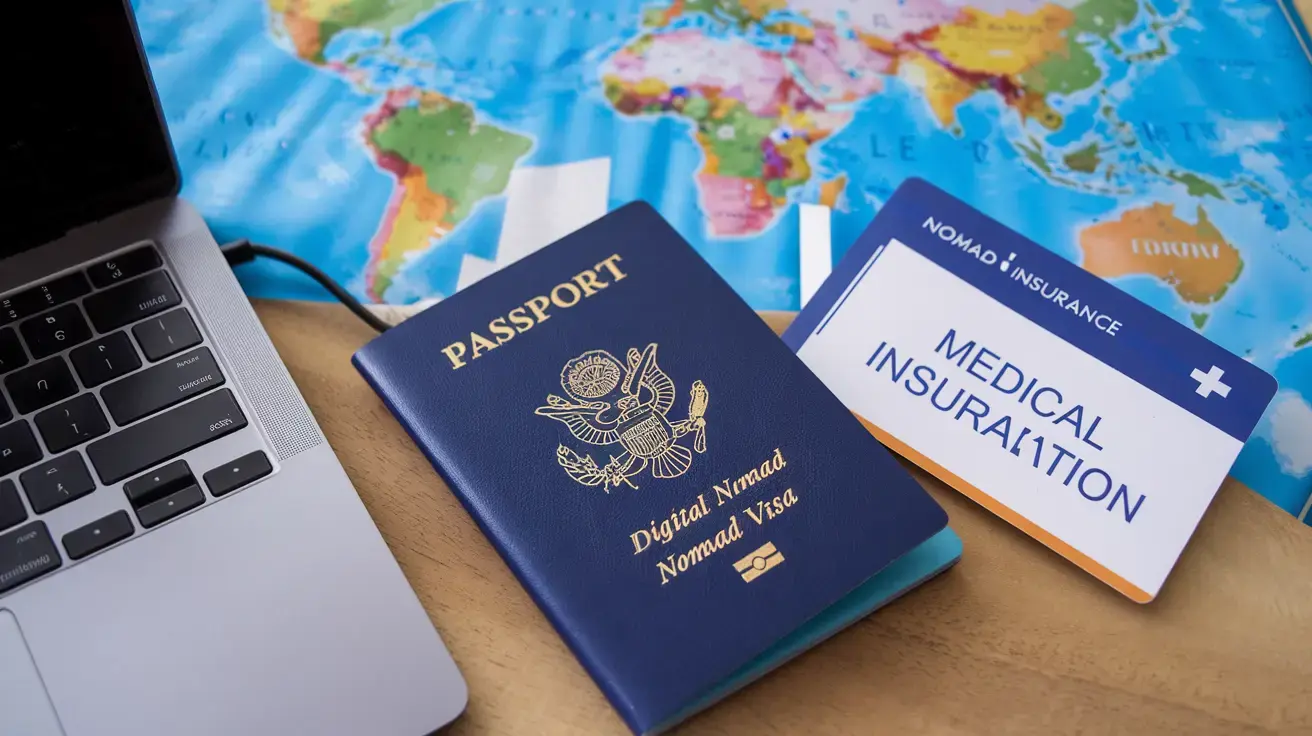Picture This:
You’re working from a beachside café in Bali when sudden stomach pains leave you searching for medical help in an unfamiliar country. Or perhaps you’re settling into your co-working space in Portugal when you realize your digital nomad visa application requires proof of comprehensive health coverage. Are you actually covered for these scenarios? For the growing community of location-independent professionals, healthcare isn’t just a checkbox—it’s a critical lifeline when thousands of miles from home.
Unlike traditional travel insurance that typically covers only emergencies and short-term trips, digital nomad health insurance addresses the unique needs of those living and working abroad long-term. With varying healthcare quality across countries and often without a stable support network, remote workers face distinctive challenges when it comes to maintaining their health on the road.
From routine check-ups to specialist consultations, mental health support to emergency evacuations—the right insurance policy can mean the difference between continuing your nomadic lifestyle with confidence or facing financial disaster when illness strikes.
In this comprehensive guide, we’ll explore everything you need to know about securing proper medical coverage as a digital nomad:
The essential components of robust insurance policies, crucial factors to consider when selecting coverage, top providers designed specifically for remote workers, visa requirements across popular destinations, and practical strategies for managing your healthcare while abroad. Whether you’re a seasoned nomad or preparing for your first remote work adventure, understanding your health insurance options is the first step toward true location independence. 💻🌎🏥
Understanding Digital Nomad Health Insurance Needs
Why Traditional Travel Insurance Falls Short?

You’re packed and ready for your digital nomad adventure, but there’s a glaring issue with that standard travel insurance policy you just bought: it wasn’t designed for people like you.
Traditional travel insurance is built for vacationers – those two-week holiday-makers who just need coverage for a short trip abroad. These policies typically cover emergency medical treatment, trip cancellations, and lost luggage. Great for tourists, problematic for nomads.
The biggest limitation? Time restrictions. Most travel insurance plans cap coverage at 30-90 days. When you’re hopping between Bali co-working spaces and Lisbon cafés for months or years, this just doesn’t cut it.
Then there’s the “home country” problem. Traditional policies assume you’re returning to a permanent residence where you have primary healthcare. But what if you’ve given up your apartment and health insurance back home? You’re stuck in an expensive coverage gap.
Work-related injuries? Not covered. Need routine healthcare like dental checkups or prescription refills? Nope. Mental health support? Rarely included.
The Difference Between Travel Insurance and Digital Nomad Health Insurance
The differences between these two types of insurance are crucial to understand:
| Travel Insurance | Digital Nomad Health Insurance |
|---|---|
| Short-term coverage (typically 30-90 days) | Long-term coverage (6-12 months or more) |
| Emergency-focused | Includes both emergency and routine care |
| Expects you to return “home” | Designed for those without a permanent residence |
| Limited or no coverage for remote work injuries | Often includes coverage for workspace accidents |
| Minimal preventative care | Includes wellness and preventative services |
| Usually excludes pre-existing conditions | Many plans cover stable pre-existing conditions |
| Limited mental health support | Often includes telehealth and mental health services |
Unique Health Risks for Location-Independent Workers
Digital nomads face distinctive health challenges that traditional workers don’t:
Working from beachside cafés sounds idyllic until you realize the ergonomic nightmare you’ve created. Improvised workstations lead to repetitive strain injuries, back problems, and neck pain at alarming rates among nomads.
Then there’s the constant timezone-hopping. Your sleep schedule is perpetually jet-lagged, compromising your immune system and mental health. Speaking of mental health – isolation and burnout are silent epidemics in the nomad community.
Environmental risks multiply when you’re constantly on the move. One month you’re navigating Delhi’s air pollution, the next you’re dealing with mosquito-borne diseases in Thailand. Each new location brings unique health hazards that your body hasn’t adapted to.
Access to quality healthcare varies dramatically worldwide. That stomach bug in Mexico might mean a simple clinic visit, but in some locations, finding English-speaking doctors or properly equipped facilities becomes a genuine challenge.
Digital nomad insurance needs to address these specific risks – providing coverage that travels with you seamlessly across borders while accounting for the unique health challenges of the location-independent lifestyle.
Key Components of Comprehensive Digital Nomad Coverage
A. Preventative Care vs. Emergency-Only Coverage
Most nomads make a critical mistake when choosing insurance: they focus solely on emergency coverage.
Sure, knowing you’re covered if you break your leg hiking in Bali is important. But what about that nagging cough that won’t go away? Or the prescription you take daily?
Here’s the real difference:
| Emergency-Only | Comprehensive Preventative |
|---|---|
| Covers accidents and sudden illnesses | Includes regular checkups and screenings |
| Usually cheaper monthly premiums | Helps catch issues before they become emergencies |
| Often has higher deductibles | May include vaccination coverage |
| No coverage for ongoing conditions | Covers prescription medications |
The truth? Emergency-only plans might save you money upfront, but can cost thousands if you need regular medical attention. Digital nomad medical insurance with preventative care might cost $50-100 more per month, but saves you from paying $200+ out-of-pocket for each doctor visit.
B. Ongoing Treatment and Routine Checkups
Working remotely doesn’t mean your health needs disappear.
The best digital nomad insurance plans understand this and offer coverage for:
- Annual physical exams
- Dental cleanings (yes, your teeth still matter in Thailand!)
- Vision checks and prescription updates
- Women’s and men’s health screenings
- Vaccination updates
What’s the catch? Geographic restrictions. Many plans require you to return to your home country for routine care, which defeats the purpose of nomad insurance.
Look for plans that allow routine care internationally with in-network providers. Some insurers now have global networks where you can get your annual checkup in Prague one year and Buenos Aires the next.
C. Mental Health Support Options
Remote work freedom is amazing, but isolation and culture shock are real challenges.
Top-tier nomad health insurance now includes:
- Virtual therapy sessions regardless of your location
- Coverage for prescription mental health medications
- Crisis support hotlines with international access
- In-person therapy with local providers (in select countries)
The mental health support gap in nomad insurance is closing, but slowly. Only about 40% of plans offer comprehensive mental health coverage.
If you already use mental health services, prioritize this in your policy. Don’t assume it’s included – explicitly check the mental health section before purchasing.
D. Coverage for Adventure Activities and High-Risk Locations
You didn’t become a digital nomad to sit in cafés all day (though we all do plenty of that).
Standard policies often exclude:
- Scuba diving below certain depths
- Motorcycle riding
- Rock climbing
- Skiing off designated trails
- Any professional or competitive sports
And locations matter too. Some policies won’t cover you in:
- Countries with active travel warnings
- War zones or political unrest areas
- Regions with known disease outbreaks
- Remote areas far from medical facilities
The solution? Riders and add-ons. Most quality digital nomad insurance allows you to add specific coverage for adventure activities. These typically cost 15-30% more but prevent the nightmare scenario of a $50,000 medical evacuation bill after your jungle trekking accident.
Always check exclusions before booking that bungee jump or motorcycle tour.
Essential Factors to Consider When Choosing a Policy
A. Global vs. Regional Coverage Areas
Ever hopped on a plane without checking if your insurance follows you? Big mistake. When choosing digital nomad medical insurance, coverage area is probably the most critical factor.
Global coverage means you’re protected wherever your laptop takes you. Bouncing from Bali to Barcelona to Bogotá? Global coverage has your back. But here’s the catch – it’s usually pricier.
Regional coverage, on the other hand, limits you to specific areas like “Europe” or “Southeast Asia.” It’s cheaper, but the second you step outside those boundaries? You’re walking without a safety net.
Here’s a quick breakdown:
| Coverage Type | Pros | Cons |
|---|---|---|
| Global | Protection everywhere, No travel restrictions | Higher premiums, May include countries you’ll never visit |
| Regional | More affordable, Often more tailored benefits | Restricts your movement, Emergency evacuations can be complicated |
The real question isn’t just where you’re planning to go – it’s where you might end up. That last-minute decision to join friends in a different continent? Make sure your insurance can keep up with your spontaneity.
B. Maximum Coverage Amounts and Deductible Levels
The numbers game matters. A lot.
Your maximum coverage amount is basically how much your insurance will shell out if things go seriously wrong. Medical emergencies abroad can rack up bills faster than you’d believe. A simple appendectomy in Singapore? Could cost $15,000+. A serious accident requiring evacuation? We’re talking six figures.
Most decent nomad policies start at $250,000 coverage and go up to $1,000,000 or even unlimited. Don’t cheap out here.
Now, about deductibles – that’s what you pay before insurance kicks in. The math is simple:
- Lower deductible = Higher premium
- Higher deductible = Lower premium
But here’s what nobody tells you: Look at the per-incident vs. annual deductible distinction. Some policies reset your deductible for each new medical issue, while others have you meet it once per year.
If you’re young and healthy, a higher deductible might make sense. Just make sure you actually have that money available in your emergency fund.
C. Duration Flexibility and Long-Term Options
The nomad lifestyle isn’t about rigid schedules. Your insurance shouldn’t be either.
Traditional travel insurance typically caps at 30-90 days. True digital nomad policies offer much more flexibility:
- Month-to-month plans you can extend while abroad
- Annual policies with continuous coverage
- Multi-year options for the truly committed wanderers
What’s really worth watching for are the renewal conditions. Some insurers make you return home to renew. Others let you extend from anywhere with a WiFi connection.
Also pay attention to how they handle breaks in coverage. Planning to visit home for a month? Some policies let you pause coverage, while others might force you to cancel and restart – potentially losing benefits for pre-existing conditions.
The best policies grow with your lifestyle. Maybe you’re testing the waters with a 3-month trip now, but next year you might go full nomad. Look for insurers that let you transition between short and long-term plans without medical reassessment.
D. Home Country Coverage Implications
Think you don’t need insurance when you visit home? Think again.
Most nomad insurance policies limit or exclude coverage in your home country. This creates a serious gap for many digital nomads who still spend weeks or months at home each year.
Typical scenarios you’ll encounter:
- No home country coverage whatsoever
- Limited coverage (like 15-30 days per year)
- Full coverage but at higher rates
- Coverage only for unexpected emergencies, not routine care
This gets even trickier if you’ve given up your domestic health insurance. Suddenly, a quick trip home for the holidays means you’re unprotected exactly where healthcare costs might be highest (looking at you, USA).
Smart nomads either maintain basic domestic coverage or choose nomad policies that include substantial home country benefits. Some even coordinate their home visits to align with those coverage windows.
Remember: Your residency status can also affect eligibility. If you’re no longer officially “resident” in your home country, some domestic insurance options disappear entirely.
E. Digital Health Services Availability
When you’re working from a beachside cafe in Thailand, you don’t want to decipher a complex healthcare system for a minor issue.
Modern nomad insurance increasingly offers digital health services that can save you enormous hassle:
- 24/7 telemedicine consultations
- Digital prescription services
- Mobile apps for claims submission
- GPS-enabled hospital locators
- Medical translation services
These digital tools aren’t just convenient – they’re game-changers when you’re in places with language barriers or unfamiliar medical systems.
Look for policies that offer video doctor consultations in your language. The best ones even have direct billing relationships with international hospital networks, meaning you won’t have to pay upfront and wait for reimbursement.
The quality of these digital services varies wildly between insurers. Some have slick, modern platforms that work seamlessly across devices. Others offer bare-bones services that feel stuck in 2010. Ask for a demo or trial of their digital tools before committing.
For chronic condition management, check if they offer digital monitoring programs that work internationally. The best nomad insurance doesn’t just cover emergencies – it helps you stay healthy wherever you roam.
Top Insurance Providers for Digital Nomads
A. SafetyWing: Nomad Insurance vs. Nomad Health Plans
Ever felt like insurance companies just don’t get the digital nomad lifestyle? SafetyWing totally flips this script.
Their Nomad Insurance starts at just $45 per month for travelers under 35, making it one of the most affordable options out there. It covers you in 180+ countries, includes some basic COVID-19 coverage, and even lets you pop back to your home country occasionally (30 days every 90 days for most nationalities).
But here’s the real kicker – their Nomad Health plan takes things up several notches. For about $153 monthly, you get comprehensive global coverage including:
- Zero deductible on outpatient care
- Full coverage for cancer treatment
- Mental health support (because nomad burnout is real)
- Preventative care that actually prevents issues
The difference? Nomad Insurance is travel insurance with some medical benefits, while Nomad Health is true international health insurance designed for long-term global living.
B. Genki, GeoBlue, and World Nomads Offerings
Genki burst onto the scene as the cool new kid with straightforward pricing ($39/month base rate) and serious perks for remote workers. Their mental health coverage is actually usable, and they’ve eliminated that annoying “home country exclusion” that plagues most digital nomad policies.
GeoBlue caters to Americans with exceptional overseas coverage and the massive Blue Cross Blue Shield network backing them. Their Xplorer plan lets you maintain U.S. coverage while globetrotting, but brace yourself for premium pricing ($250+ monthly for comprehensive plans).
World Nomads remains the adventurer’s go-to with their extreme sports coverage. Mountain biking in Chile? Scuba diving in Thailand? They’ve got you. Their two-tiered system (Standard/Explorer) ranges from $120-200 monthly depending on your adventure appetite. The drawback? It’s designed for shorter trips, not permanent nomading.
C. Atlas Travel, Insured Nomads, and Integra Global Benefits
Atlas Travel hits that sweet spot between affordability and solid coverage, starting around $40-100 monthly depending on your age and deductible choices. Their COVID-19 coverage became legendary during the pandemic, and their claims process is surprisingly pain-free.
Insured Nomads took a tech-first approach that actually works. Their INC membership comes bundled with insurance and includes some serious tech perks: a global VPN, cybersecurity protection, and an emergency response app. Monthly premiums hover around $125+ but the added digital security might be worth every penny.
Integra Global offers something many nomads eventually need: transition plans between short-term coverage and permanent international health insurance. Their Freedom Health plan covers everything from routine checkups to emergency evacuation with monthly costs around $175-250. They shine for nomads settling into semi-permanent bases or traveling with families.
D. Price Comparison Based on Age and Coverage Needs
| Provider | 25-35 Years Old | 36-45 Years Old | 50+ Years Old | Best For |
|---|---|---|---|---|
| SafetyWing Nomad Insurance | $45/month | $71/month | $132/month | Budget travelers, beginners |
| SafetyWing Nomad Health | $153/month | $207/month | $352/month | Long-term nomads needing comprehensive care |
| Genki | $39/month + add-ons | $65/month + add-ons | $110/month + add-ons | Tech workers with occasional travel |
| World Nomads | $120-170/month | $150-220/month | $200-300/month | Adventure travelers, short trips |
| Insured Nomads | $125/month | $180/month | $295/month | Security-conscious digital professionals |
| Atlas Travel | $45-100/month | $75-150/month | $150-300/month | Flexibility seekers with varying trip lengths |
| Integra Global | $175/month | $250/month | $375/month | Families, long-term international residents |
Your age dramatically impacts premiums, but so does your lifestyle. Adventure sports enthusiasts should prioritize World Nomads or Atlas Travel. Those with chronic conditions will find SafetyWing Nomad Health or Integra Global more accommodating. Budget-conscious newcomers might start with basic SafetyWing Nomad Insurance before upgrading as their nomad journey evolves.
Digital Nomad Visa Requirements and Insurance
Meeting Mandatory Insurance Requirements for Visa Applications
Getting a digital nomad visa isn’t just about having a remote job and a cool Instagram feed. Most countries want proof you won’t become a healthcare burden. That’s where mandatory insurance requirements come in.
Countries like Portugal, Estonia, and Costa Rica don’t just suggest insurance—they demand it. And they’re not looking for bare-bones coverage either. Most require:
- Minimum coverage amounts (typically €30,000+ in Europe)
- Emergency medical evacuation
- Repatriation of remains (morbid but necessary)
- COVID-19 coverage (still a thing in 2025)
The trick? Regular travel insurance often doesn’t cut it. These visas typically require long-term international health plans that cover you for 6-12 months.
Here’s a real headache: some countries want proof of insurance from providers they recognize. Show up with the wrong insurance card, and you might be shopping for flights home instead of setting up your remote office at that beachside café.
Country-Specific Healthcare Regulations
The healthcare game changes dramatically depending on which country you’re targeting.
Thailand’s digital nomad visa requires at least $50,000 in coverage. Croatia wants €30,000. And both demand local insurance companies or internationally recognized providers with specific documentation formats.
Some standout examples:
| Country | Minimum Coverage | Special Requirements |
|---|---|---|
| Portugal | €30,000 | Must cover entire visa duration |
| Estonia | €30,000 | Must include emergency treatments |
| Dubai | $100,000 | UAE-approved provider only |
| Costa Rica | Coverage for entire stay | Local insurance or international plan with Costa Rican partnership |
When State-Funded Insurance Isn’t Available to Nomads
Many nomads come from countries with universal healthcare, then face a rude awakening abroad. Your home country’s cushy coverage typically stops at the border.
The truth: most national healthcare systems are designed for residents, not visitors. Even digital nomad-friendly top countries like Germany, which has amazing public healthcare, won’t let you access it until you’ve established residency (often requiring 1-2 years of living there).
Some countries offer pay-in options for their public systems, but the majority don’t. Even the EU’s much-praised EHIC card only works for temporary travelers, not long-term digital nomads.
This gap forces nomads to either:
- Purchase private international health insurance
- Use country-specific private plans (changing every time you move)
- Risk going uninsured (terrible idea)
The nomad dream isn’t cheap when healthcare enters the equation. But going without coverage isn’t just risky—it could mean immediate visa revocation if discovered.
Managing Your Healthcare While Abroad
Making Insurance Claims from Foreign Countries
Dealing with medical issues while working remotely is stressful enough without the added headache of filing insurance claims from another country. But it’s not as complicated as it seems.
Most digital nomad insurance providers now offer mobile apps where you can submit claims with a few taps. Take photos of your medical receipts, upload them through the app, and you’re done. No more mailing physical documents across continents!
Still, there are some tricks to make the process smoother:
- Keep digital copies of everything. I mean everything: prescriptions, doctor’s notes, receipts, test results.
- Get itemized bills whenever possible. “Medical services” isn’t specific enough for most insurers.
- Ask for documentation in English when you can, or use translation apps for important medical terms.
- Check time limits for filing claims. Some insurers require submission within 30-90 days.
Pro tip: Before you even step into a doctor’s office, check if your insurance allows direct billing. This way, the provider bills your insurance directly, and you don’t have to front the money yourself.
Accessing Global Healthcare Provider Networks
One of the biggest perks of good nomad insurance? Access to pre-vetted healthcare providers worldwide.
Most quality insurance plans have partnered with hospital networks spanning major digital nomad hotspots. This means you can walk into a hospital in Bali, Mexico City, or Lisbon knowing they understand your insurance coverage.
When choosing insurance, look at their provider network in your planned destinations. The bigger the network, the less likely you’ll have to pay out-of-pocket and claim later.
Many insurers now offer:
- 24/7 provider locator services
- Virtual consultations with English-speaking doctors
- Concierge services to book appointments
Remember that hospital quality varies wildly across countries. Your insurance’s network typically includes facilities that meet international standards—something you definitely want when you’re sick in an unfamiliar place.
Financial Tools for Managing Insurance Payments Internationally
The financial side of managing healthcare abroad can get tricky. Exchange rates, international transaction fees, and reimbursement delays can add up quickly.
Smart nomads use these financial tools to stay on top of insurance payments:
- Multi-currency accounts like Wise or Revolut minimize currency conversion fees when paying premiums or receiving reimbursements
- Digital wallets provide quick access to funds for emergency treatments
- Credit cards with no foreign transaction fees for immediate medical payments
- Health Savings Accounts (for US citizens) that work internationally
Insurance premiums can be a significant monthly expense. Consider paying quarterly or annually if your insurer offers discounts for larger payment chunks.
And watch those claim reimbursements closely. International bank transfers can take 5-10 business days, with money sometimes getting held up by intermediary banks. Set up direct deposit whenever possible to speed things up.
Many nomads keep an emergency fund specifically for medical expenses—enough to cover potential out-of-pocket costs until reimbursement arrives.
Conclusion: Wrapping Up Your Digital Nomad Insurance Journey
Navigating health insurance as a digital nomad doesn’t have to be overwhelming. As we’ve explored throughout this guide, securing comprehensive coverage is not just about meeting visa requirements it’s about protecting your health and financial well-being while embracing location independence.
From understanding the fundamental difference between traditional travel insurance and digital nomad-specific policies to evaluating key factors like coverage areas, deductibles, and monthly premiums, you now have the knowledge to make an informed decision that suits your unique lifestyle.
Remember that your health insurance needs may evolve as your nomadic journey progresses. Whether you choose SafetyWing, Genki, GeoBlue, World Nomads, or another provider mentioned in our guide, prioritize policies that offer both emergency support and routine care access.
As you prepare for your digital nomad adventure, connect with communities like Nomads Embassy for additional support and resources. With the right insurance coverage in place, you can focus on what truly matters experiencing the world while working on your terms, knowing you’re protected wherever your journey takes you.











